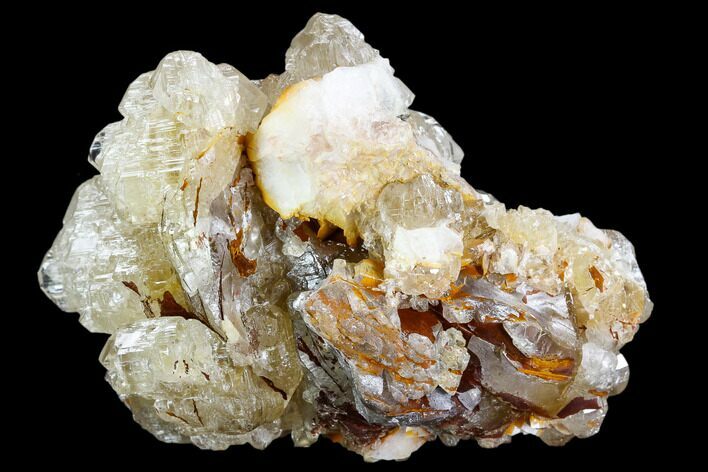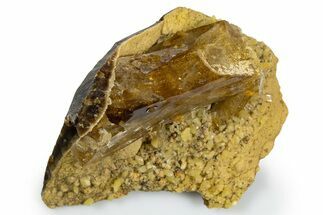This Specimen has been sold.
2.9" Cerussite Crystal Cluster - Morocco
This is a fantastic cluster of cerussite crystals that were collected from Mibladen, Morocco. Small aggregations of white bladed barite can be found on what could be considered the underside of the specimen.
Under UV lighting, the cerussite crystals fluoresce a vibrant yellow color.
Under UV lighting, the cerussite crystals fluoresce a vibrant yellow color.
About Cerussite
Cerussite is a lead-carbonate mineral with the chemical formula PbCO3, and is an important ore of lead. It is a common weathering product of galena, explaining why it is typically extracted from oxidized zones of lead ore deposits. It can form into a variety of different structures, sometimes in fibrous patterns and other times in granular aggregations, though it generally forms vitreous pseudo-hexagonal crystals. Its colors vary depending on composition and structure: it is most commonly colorless, white, grey and green-tinted.
Cerussite is a lead-carbonate mineral with the chemical formula PbCO3, and is an important ore of lead. It is a common weathering product of galena, explaining why it is typically extracted from oxidized zones of lead ore deposits. It can form into a variety of different structures, sometimes in fibrous patterns and other times in granular aggregations, though it generally forms vitreous pseudo-hexagonal crystals. Its colors vary depending on composition and structure: it is most commonly colorless, white, grey and green-tinted.
About Barite (Baryte)
Barite is a barium sulfate mineral (BaSO₄) known for its high specific gravity, which makes it unusually heavy for a non-metallic mineral. Typically forming in tabular or bladed crystals, barite can also appear in massive, fibrous, or nodular habits. Its colors range from colorless and white to shades of blue, yellow, gray, or brown, often influenced by trace impurities. Barite commonly forms in hydrothermal veins, sedimentary rocks, and as a gangue mineral in lead-zinc ore deposits. It is widely used in industrial applications, especially as a weighting agent in drilling muds for oil and gas exploration. Its striking crystal formations and vivid hues also make it a popular mineral for collectors.
Barite is a barium sulfate mineral (BaSO₄) known for its high specific gravity, which makes it unusually heavy for a non-metallic mineral. Typically forming in tabular or bladed crystals, barite can also appear in massive, fibrous, or nodular habits. Its colors range from colorless and white to shades of blue, yellow, gray, or brown, often influenced by trace impurities. Barite commonly forms in hydrothermal veins, sedimentary rocks, and as a gangue mineral in lead-zinc ore deposits. It is widely used in industrial applications, especially as a weighting agent in drilling muds for oil and gas exploration. Its striking crystal formations and vivid hues also make it a popular mineral for collectors.
 Reviews
Reviews














